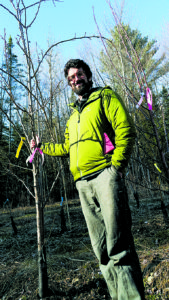By David Fried
There are at least three great reasons for fall planting:
- The earth is moist, and it will be raining or snowing for the next six months, so the new plantings will receive all the moisture they need without having to water them. This is especially good for those without time to water, or who don’t live full time at the same place where you are planting.
- Many people think you have to wait for spring to plant, but you lose a few growing seasons. When you plant in fall the tree or shrub much prefers being in the earth than in its pot. It will begin to grow in mid- or late March, way before anyone even considers planting in the north. This means you get fruit and flowers a lot sooner as you are gaining a few seasons of growth, especially that early spring when they really take off!
- We don’t have as much to do as we do in springtime. When we plant now we have something to look forward to in our landscape when the snow melts.
At Elmore Roots, we have been successfully planting fruit trees, nut trees and berry plants for 36 years in the fall. We save time not having to water them all spring and summer, like we would if we waited until then to plant. When you plant well rooted trees in September, October or November, they will usually grow very well and give you many years of fruit and flowers, except you will not have to wait as long or work as hard to get it!
Paw paws are fun to grow, and you can plant them in the fall, too. About 15 years ago we saw paw paws ripening on some trees in Bristol, Vermont. We dug up some shoots (after asking of course) and planted them around our hill. Some of them have grown, and we have added more. Neal Peterson has searched all over America for the best and tastiest cultivars of paw paw. I wrote to him and asked which ones would be the best for our northern Vermont climate. It turns out the key is to have early ripening ones, like “Pennsylvania Golden” or “Sunflower.” These are some of the ones we offer at our nursery.
Paw paws are the most northern species of a fruit that include soursop and cherimoya. The fruits are large and delicious, and the leaves look like tropical rainforest leaves, ornamental in their own right. Ours have not fruited yet, but they do not show any winter dieback, just moose and deer nibbling.
We carry in our nursery store and recommend the new paw paw book, Pawpaw — In Search of America’s Forgotten Fruit. It will inform you about the adventure and excitement of growing this lesser known fruit that zebra swallowtails need to survive. I guarantee it will spark a lot of conversation and be a point of interest in your yard. By the way, you need two different varieties for pollination. Why not plant three, in case one does not make it? You double your chances of a big ripe succulent harvest.
David Fried grows paw paws at Elmore Roots Nursery both in full sun and as a south side understory of sugar maples. He often plants more out each year in the fall.










Leave a Reply